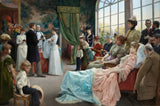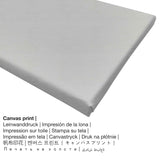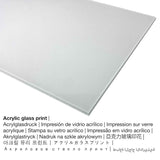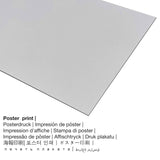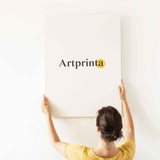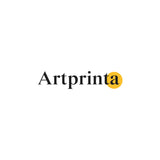Julius LeBlanc Stewart, 1892 - Baptizim - mbipụta nka mara mma
Ụtụ gụnyere. Mbupu gbakọrọ na ndenye ọpụpụ.
Nkọwa ngwaahịa nka
Ihe osise The Baptism nke nwoke mere American onye na-ese ihe Julius LeBlanc Stewart n’afọ 1892. Ihe gafere 120 Original dị afọ nwere nha: 79 1/4 x 117 1/4 na (201,30 x 297,50 cm). Mmanụ na kwaaji was applied by the painter as the medium of the piece of art. Besides, the artwork belongs to the art collection of Ebe ngosi nka nke Los Angeles County, nke dị na Los Angeles, California, United States of America. Site n'ikike nke: Ụlọ ihe ngosi nka nke Los Angeles County (www.lacma.org) (license - public domain).Creditline of the artwork: . What is more, the alignment is landscape and has a side ratio of 3 : 2, meaning that ogologo bụ 50% ogologo karịa obosara. The painter Julius LeBlanc Stewart was a North American artist from United States, whose art style can be attributed mainly to Realism. The painter lived for 64 years and was born in the year 1855 in Philadelphia, Philadelphia county, Pennsylvania, United States and died in the year 1919 in Paris, Ile-de-France, France.
Supplemental information by Los Angeles County Museum of Art (© Copyright - Los Angeles County Museum of Art - Ebe ngosi nka nke Los Angeles County)
Stewart’s paintings of the elegant and fashionable world in which he lived were sometimes inspired by specific events and often included his friends. In The Baptism he depicted with a studied realism an elaborate interior and the costume of members of high society gathered to witness the baptism of one of their own. The realistic details suggest that the figures were portraits of specific persons. In Stewart’s earlier painting The Hunt Ball, a key was provided to identify many of the figures. No key is known to exist for The Baptism. The painting has been traditionally considered to be of the Vanderbilts, but all attempts to substantiate this have proved fruitless. Although most of the male figures have distinctive physiognomies, Stewart’s social world was so large encompassing not only Americans but those of many nationalities-that identification is difficult. The art historian Sue Carson Joyner has suggested that the male standing on the far right is a self-portrait. Stewart usually idealized his female figures, giving them handsome, aristocratic profiles, so the similarities among female figures in his paintings can be misleading. The painting was probably not a specific commission, for Stewart was too wealthy to need such work, nor would he have offered it for sale if it were. The painting probably records the baptism of a friend’s child, indicated by the faint inscription of a day and time on the back of the painting, but was not intended to record the event for the public. The Baptism was the culmination of Stewart’s development of elaborate multifigured scenes; thereafter he limited his compositions to smaller groupings. Although the identities of the people remain an enigma, the painting can be appreciated on its own terms. It is a tour de force of technical skill and a prime example of late nineteenth-century academic aesthetics. The persuasiveness of Stewart’s depiction of natural light suggests the fascination with outdoor effects that were just emerging in his art. The picture met with great acclaim at an international exposition held in Berlin in 1895. The realistic illusion of the rich damask wall coverings, the silk, satin, and lace trim of the figures’ attire, and the soft, delicately rendered skin of the women and children captivate viewers even today.
Notes from the Contributor: Purchased with funds provided by the Museum Acquisition Fund, Mr. and Mrs. William Preston Harrison Collection, Mr. and Mrs. J. Douglas Pardee, Jo Ann and Julian Ganz, Jr., Mr. and Mrs. Charles C. Shoemaker, Mr. and Mrs. William D. Witherspoon, Mr. and Mrs. Thomas H. Crawford, and other donors
Nkọwa nka ahaziri
| Iberibe aha nka: | "The Baptism" |
| Nchịkọta nke ọrụ nka: | sere |
| Okwu nche anwụ: | nkà nke oge a |
| Narị afọ nka: | 19th narị afọ |
| Ekepụtara: | 1892 |
| Afọ nka: | ihe dị ka afọ 120 |
| Usoro izizi: | mmanụ na kwaaji |
| Akụkụ izizi (ọrụ nka): | 79 1/4 x 117 1/4 na (201,30 x 297,50 cm) |
| Ụlọ ihe ngosi nka: | Ebe ngosi nka nke Los Angeles County |
| Ebe ngosi nka: | Los Angeles, California, Njikota Obodo Amerika |
| URL webụ: | www.lacma.org |
| Akwụkwọ ikike nka: | ngalaba ọha |
| Site n'aka: | Ụlọ ihe ngosi nka nke Los Angeles County (www.lacma.org) |
Banyere onye na-ese ihe
| aha: | Julius LeBlanc Stewart |
| Aha utu aha: | Julius Stewart, J. Stewart, Stewart Julius, Jules Stewart, Stewart, Stewart Jules L., Stewart Julius L., Stewart Julius LeBlanc, Julius LeBlanc Stewart |
| okike nke onye nka: | nwoke |
| Obodo onye nka: | American |
| Ọrụ: | onye na-ese ihe |
| Obodo onye nka: | United States |
| Otu nka: | omenkà nke oge a |
| Ụdị nka: | Ihe ngosi |
| Ndụ: | 64 afọ |
| Afọ ọmụmụ: | 1855 |
| Ebe amụrụ onye: | Philadelphia, Philadelphia County, Pennsylvania, Njikota Obodo Amerika |
| Afọ ọnwụ: | 1919 |
| Nwuru na (ebe): | Paris, Ile-de-France, France |
Akụrụngwa ị nwere ike isi na ya nweta
Maka mbipụta nka ọ bụla anyị na-enye nha & ihe dị iche iche. Nha na ihe ndị a bụ nhọrọ anyị na-enye gị maka nkeonwe:
- Mbipụta iko acrylic (nke nwere ezigbo mkpuchi iko): The acrylic glass print, which is often described as a print on plexiglass, makes the original artwork into amazing décor and makes a good alternative to canvas or aluminium dibond prints. With an acrylic glass art print contrasts and also minor image details will be more visible due to the very subtle gradation.
- Mpempe akwụkwọ ederede (akwa akwa akwa): Our poster is a UV printed cotton canvas with a slight surface finish. A poster is designed for putting the fine art print in a custom frame. Please bear in mind, that depending on the size of the poster we add a white margin of approximately 2-6cm round about the painting in order to facilitate the framing with your custom frame.
- Kwaaji: The printed canvas, which shall not be mistaken with an artwork painted on a canvas, is a digital image printed on an industrial printer. It produces the special impression of three-dimensionality. A canvas makes a lovely and comfy feeling. Canvas Prints have the great advantage of being relatively low in weight, which implies that it is easy to hang up the Canvas print without additional wall-mounts. Therefore, canvas prints are suitable for all types of walls.
- Mbipụta nke aluminom: Aluminium Dibond prints are prints on metal with a true depth. A direct Aluminium Dibond Print is the perfect introduction to art prints manufactured with aluminum. For our Direct Print On Aluminum Dibond, we print your selected work of art right on the aluminium composite surface.
Banyere akụkọ
| Bipụta ụdị ngwaahịa: | nka nka |
| Usoro mmeputakwa: | dijitalụ mmeputakwa |
| Usoro mmepụta: | Mbipụta UV ozugbo (mbipụta dijitalụ) |
| Mmalite ngwaahịa: | emepụtara na Germany |
| Ụdị ngwaahịa: | mmepụta ihe na-achọ |
| Ojiji ngwaahịa: | Ụlọ ihe osise nka, mkpokọta nka (mmepụta) |
| Ntuziaka onyonyo: | nhazi odida obodo |
| Oke akụkụ: | 3: 2 |
| Mmetụta ihe onyonyo: | ogologo bụ 50% ogologo karịa obosara |
| Nhọrọ ihe onwunwe: | Mpempe akwụkwọ, akwụkwọ mmado (akwụkwọ kwaaji), mbipụta ọla (aluminium dibond), mbipụta iko acrylic (nwere ezigbo mkpuchi iko) |
| Mbipụta kanvas (akwa akwa na etiti ihe ndọtị): | 30x20cm - 12x8", 60x40cm - 24x16", 90x60cm - 35x24", 120x80cm - 47x31" |
| Mbipụta iko acrylic (nwere ezigbo mkpuchi iko) dị iche iche: | 30x20cm - 12x8", 60x40cm - 24x16", 90x60cm - 35x24", 120x80cm - 47x31" |
| Mbipụta akwụkwọ mmado (akwụkwọ kwaaji): | 60x40cm - 24x16", 90x60cm - 35x24", 120x80cm - 47x31" |
| Nhọrọ nha nha nke aluminom dibond (ihe aluminom): | 30x20cm - 12x8", 60x40cm - 24x16", 90x60cm - 35x24", 120x80cm - 47x31" |
| ụba: | biko mara na nka nka enweghi fremu |
Important note: We try our utmost in order to depict our art products with as many details as we can and to illustrate them visually on the various product detail pages. Nevertheless, the pigments of the print materials, as well as the print result can diverge marginally from the presentation on the device's monitor. Depending on the settings of your screen and the quality of the surface, colors may not be printed 100% realistically. In view of the fact that our art prints are processed and printed by hand, there may as well be slight variations in the motif's exact position and the size.
Nwebiisinka © - www.artprinta.com (Artprinta)

